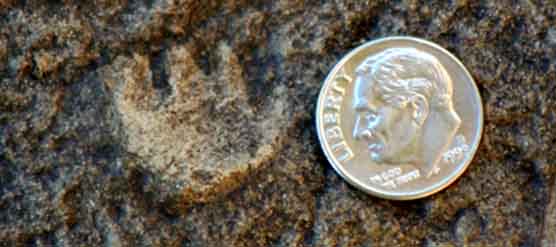|

NPS Image
Contact: Dan Chure, 435.781.7703 Contact: Mary Risser, 970.374.3001 Far up a remote canyon in Dinosaur National Monument, paleontologists have discovered a remarkable deposit of footprints made by our mammalian ancestors as they crossed the sand dunes of an ancient desert. One long ago night, some 190 million years ago, small primitive mammals left their burrows and scurried up the fronts of great sand dunes to forage for food. As they walked up the dune slopes, they left footprints with raised up back edges, where their feet had pushed against the sand to gain purchase. Later that night, the surface of the dunes were slightly moistened, perhaps by dew. That gave the sand a slight crust and strengthened the tracks just enough that they were not blown away the next day. Instead, they were buried under more sand and preserved. Those dunes became part of an ancient desert deposit known to geologists as the Glen Canyon Group. The western United States was a quite different place during the Early Jurassic. Today’s majestic mountains and spectacular deep river canyons had not yet formed. Instead, a vast desert, not unlike the Sahara Desert of modern Africa, covered most of Utah and Wyoming and parts of Colorado, Arizona, and New Mexico. This was certainly a hostile environment but not one completely devoid of life. In small areas between the major dune fields where water was present, dinosaurs, other animals, and plants eked out a living. As in modern desert environments, most of the animals were active at night when temperatures were cooler. In July 2009, two paleontologists, Dr. Dan Chure of Dinosaur National Monument and Dr. George Engelmann of the University of Nebraska, Omaha, were in their fourth summer season studying the fossils and ancient environments of the Glen Canyon Group in Dinosaur National Monument. On the side of a canyon wall among the high angle beds of the ancient dunes, they came across a rock layer that preserved the footprints of those nightly sojourns made by the primitive mammals. What is especially remarkable about the site, however, is that there are not just a few tracks made by a couple of animals, but rather many hundreds of small tracks - so many that simply counting them will be a challenge. “We were excited to find tracks of something besides dinosaurs, but we were really surprised to find so many on one surface,” said Engelmann. “Most of the tracks are about the size of a dime and some are even smaller. A few are so well preserved that individual toe impressions can be seen.” Similar tracks, known by the scientific name Brasilichnium, are thought to have been made by small mammals. The new tracks are considerably smaller than other specimens of Brasilichnium and may have been made by a different primitive mammal. Making that determination will require further study. “Mixed among the mammal footprints are other tracks that were made by larger animals, possibly small dinosaurs. This was a time when the ancestors of modern mammals were losing dominance on land to the dinosaurs,” said Engelmann. “It’s near the beginning of a long time when dinosaurs ruled and our ancestors tried to stay out of their way.” “This remarkable deposit provides an important record of the diversity of animals living in the Early Jurassic desert of North America – one for which we have almost no skeletal fossils,” Chure remarked. “Close to the mammal track site, but at a slightly lower level, we also found a trail of large scorpion, with a leg span of 10 cm.” As spectacular as the site is, it is clear that much of the trackway surface has already been destroyed by erosion. The layer undoubtedly once contained thousands of small tracks. Documenting and preserving the site will be a high priority because of the threat. “Study of the site is just in its first stages. Future work will include mapping the trackway horizon, detailed study of the tracks, determining the number of animals that made the tracks, understanding why there are so many tracks at the site, and replicating part of the layer for exhibit at the Monument,” explained Chure. “Working this site will be made more difficult because of the remote location and high angle of the rock layers, but it will be worth it because of its scientific importance. You just don’t come across this kind of discovery every day.” The dinosaur trackway is not yet open to the public, but visitors to Dinosaur National Monument are invited to hike the Fossil Discovery Trail to see dinosaur fossils in the rocks along the trail. |
Last updated: February 24, 2015
